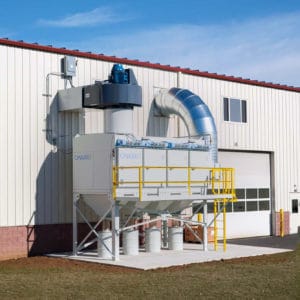In the past, we have been asked if our dust collectors are OSHA compliant. The truth is that there is no specific standard for an OSHA compliant dust collector. OSHA standards cover many different aspects of your dust collector, from electrical wiring to ladder safety. However, we assume that what most people are asking is “Will your dust collector give us OSHA compliant air quality?”.
OSHA Regulations for Dust Collectors
OSHA does not currently have a standard that regulates the function of a dust collector. But it does have housekeeping standards, which limit how much dust can accumulate in the facility. Failure to remove accumulated dust can result in an OSHA fine.
OSHA also has a National Emphasis Program for combustible dust. This program means that OSHA inspectors will be investigating facilities that might have dust problems. OSHA does not have a specific standard for how the dust needs to be removed, except the General Duty Clause. Specifically, this requires that employers take all reasonable precautions to protect workers from harm.
Further, OSHA considers dust collectors to be a form of engineering control. For control hazards, the preferred OSHA method is to remove the hazard. This would mean removing the process that makes dust. Since most facilities can’t do this, the next preferred method is an engineering control. This means a solution that is part of the process to control the hazard.
As an engineering control, a dust collector is one of OSHA’s preferred methods for controlling dust hazards. However, this does not mean it is an OSHA compliant dust collector. OSHA does not have a standard for exactly how a dust collector must be built or how it must work. The only rule is the General Duty Clause to keep employees safe.
 NFPA Standards for Dust Collectors
NFPA Standards for Dust Collectors
When many people think of OSHA regulations for dust collection, they actually mean NFPA standards. Our dust collectors, when fitted with appropriate fire and explosion control methods, meet all NFPA standards for dust collection.
NFPA standards specify how fires should be safely vented (NFPA 68) and controls for explosion prevention (NFPA 69). More recently, the NFPA has established standards for the control and safe handling of combustible dust (NFPA 652 and 654). NFPA 484 also specifically deals with combustible metals.
While there is no OSHA compliant dust collector, a dust collector may or may not meet NFPA standards. These are not OSHA regulations, and you cannot be fined for them. However, many insurance companies and local regulations use NFPA as their legal standard. OSHA may also use NFPA standards to determine if employers are providing a safe environment.
Exposure Limits Do Require OSHA Compliance
OSHA regulations do cover exposure to dust. Many types of dust certainly cause harmful effects with too much exposure. OSHA has a set exposure limit for most types of dust. While the dust collector itself may not have an OSHA regulation to meet, it helps companies meet the OSHA exposure limits.
OSHA usually regulates exposure by how much dust the person is exposed to over a typical workday. Dust collectors can remove dust from the spot where it is created (source capture) or from the entire workspace (ambient).
By removing dust from the work area, a dust collector keeps the exposure levels within OSHA compliance. Different types of dust may require different system designs to achieve this compliance. A system designer will assess each dust-producing process.
So, is there an OSHA compliant dust collector?
If you are referring to the removal of dust, there really isn’t an OSHA compliant dust collector. OSHA does not have specific regulations for dust collectors. In contrast, NFPA does have standards for dust collection systems. Therefore, most employers will need to meet these standards.
 A dust collection system is a tool to help you achieve OSHA compliance with many other standards. Dust collection systems can achieve compliance with safety, housekeeping, and exposure control. Imperial Systems’ dust collectors are designed to help you achieve compliance.
A dust collection system is a tool to help you achieve OSHA compliance with many other standards. Dust collection systems can achieve compliance with safety, housekeeping, and exposure control. Imperial Systems’ dust collectors are designed to help you achieve compliance.
A dust collector like a CMAXX needs proper safety features to help achieve this goal. This may include explosion vent panels, abort gates, explosion isolation valves, spark traps, and fire suppression. NFPA standards usually require these features for combustible dust.
To find out if you are meeting OSHA regulations in your facility, you can hire a safety consultant to review all your potential hazards. If you need to know whether your dust collector is working correctly, a ServiceMAXX visit can assess and make any needed repairs. Contact us today to schedule a ServiceMAXX visit.


